 |
 |
| 清豊寺古窯苑のまる窯焼成(初窯) First Firing at Marugama Kiln in Seihouji Pottery Kiln Laying Out Park [Photos taken on Jan. 11, 2003] |
| 2003年1月11日愛知県豊田市にある中京大学豊田キャンパス内清豊寺古窯苑(注6)に あるまる窯(美清寺窯)での焼成(初窯)を見学しました。 《2003年5月10日追記》 このまる窯から窯出しされた陶器が美山陶芸教室2階のギャラリーで展示されました。 「焼締め」「灰被り」の陶器は味わいがあります。志野のカップがありましたが、寺田康雄氏 のご長男の鉄平君に「てかてかしているのは何故か」お聞きしたところ、「釉薬は長石だけ を使い、器の上に灰が被り釉薬と融合した為とのこと。灰は熔融点が高いので、高温に しないと長石と融合しないだけでなく、灰がかかった部分が焼成されないので、違った 味わいの作品になる。」との説明を得ました。(ウェブページ作成者の解釈が入っています。) 作品等の詳細はココをクリックして下さい。 このまる窯は形はドイツの窯の形に似ており、かつて瀬戸市で活躍したが、現在では 瀬戸市でも見られなくなり、数年がかりで築窯されたものである。 古窯苑内には、まる窯の他に大窯(注5)、独特の窖窯(古窯苑で最初に築窯された)、 現在築窯中の14連の連房式登窯(岐阜県土岐市で発見された元屋敷窯《桃山陶の名品 を生み出した》を復元した窯)の合計4個の窯(完成3+築窯中1)があります。 全ての築窯は寺田康雄氏の設計指導により行われ、或いは行われつつあります。 今回、初窯の蒔入れは2003年1月8日午後6時頃ですから、今日1月11日の午後6時 で丸3日間となります。 温度を1300℃位迄上げ、その温度を一定時間保つ為、寺田氏が指導する学生を中心として 、寝ずに交替で窯内の様子を見、温度をチェックし薪を入れるわけです。この間、寺田氏は 古窯苑内に駐車した自家用車の中に布団を持ちこんで仮寝をするわけです。 後は窯の火を止めてから、数日後?(寺田氏に聞き忘れたので後日確認)、窯出しになります。 窯出しの時にこれまでの焼成の成果が決まるので最も緊張する時でしょう。 まる窯内には、釉薬が掛けてある陶器、掛けてない陶器(窯内の灰かぶりで灰釉を付ける)、 陶磁器が寺田氏が決めた位置に配置されています。全て、各作品の特徴を把握している 寺田氏の指示通りでないと焼成結果に不良が発生するためです。 以下の写真で古窯苑の概要とまる窯の焼成をご案内します。 On January 11, 2003, I visited to see this year's First Firing at Marugama Kiln in Seihouji Pottery Kiln Laying Out Park. The Park(注6) is located at Toyota Campus of Chukyu University in Toyota city, Aichi prefecture. 《Additionally written on May 10, 2003》 The ceramics pulled out from Marugama kiln were exhibited at the gallery of the second floor of the Bizan Ceramic Art classroom. I m not bored with pottery with "Yakijime" (firing without glazing) or with "Haikaburi" (clay-formed body covered with burend ash) even if looking at it for long time. I found a cup with Shino-glaze and asked Mr. Yasuo Terada's eldest son, Teppei, "Why is it that gloss is shown on the surface?" He replied "since only feldspar was used as glaze, ashes covers the cup and the ashes and glaze united on the cup. Ashes are not united with feldspar, unless ashes raise temperature more than the melting temperature, since the melting temperature is high. In addition, the portion covered with ashes is not fired. So, the fired pottery becomes the work of a different taste." (The interpretation of a web page maker is contained in above-mentioned Mr. Teppei's reply.) Please click this for the detail of the pottery work, etc.。 The shape of this Kiln looks like that in Germany, and the kilns had played important roll in Seto before, but could not be found anymore at present. So, this Marugama Kiln has been made in several years. Besides this Marugama kiln, Ohgama kiln(Note 5), unique Anagama kiln (made at this park in the first place), and a climbing kiln with 14 firing chambers under construction (this climbing kiln will be restored to its original state of Motoyashiki-gama kiln which was found at Toki city, Gifu prefecture; 《Motoyashiki-gama kiln produced masterpieces of Momoyama style pottery》) are laid out in the park. All the kilns have been completed or under construction by Mr.Terada's supervision on the design. First firing at Marugama kiln this year started at about 6 pm on Jan. 8, 2003 and the firing continues today on Jan. 11. In order to heat up the temperature inside the kiln to about 1300℃ and keep it for a certain time, students who Mr. Terada teaches watch the temperature and put wood needed into the kiln. While, he takes a nap in his station wagon where he brings in a futon or bedclothes. Several days after stopping putting wood, potteries and porcelains will be taken out from the kiln. The time of taking out them will be the most tense moment because the moment reveals whether they have been fired well or not. In Marugame kiln, potteries with glaze, those without glaze (The scattering ash inside the kiln covers the fired potteries and melts, and then coats the surface - this phenomenon is called "Haikaburi". This Haikaburi is expected on those without glaze) and porcelains are put in place properly in the kiln exactly in accordance with his instruction. He grasps .the know-how on the firing result. The following photos show the outline of the park including Anagam kiln and Ohgama kiln and the firing in Marugama kiln. |
| まる窯、窖窯、熱海で焼成した作品 (モニュメント)を上から望む Marugama kiln, Anagama kiln and Monument fired at Atami, Shizuoka pref. |
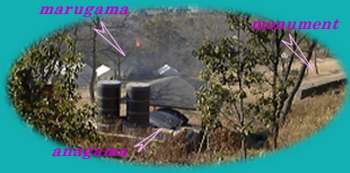 |
| 萱葺き屋根の裏門より まる窯を望む(注1) Viewing Marugama kiln from a rear gate with a thatched roof (Note1) |
坂の上から見たまる窯の頂部 (煙突から炎が吹き出ている) Top of Marugama kiln viewed from the upper part of a slope (flame blows out from a chimney) |
まる窯正面 Front of Marugama kiln |
 |
 |
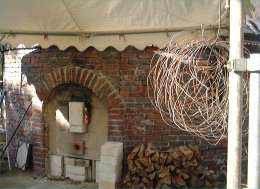 |
| 焼成した見本(注2) Samples fired in Marugama (Note2) |
焼成中の見本(注3) One of samples under fire in Marugama(Note3) |
 |
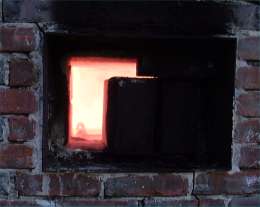 |
| かつて熱海の窯で 焼成した作品(注4) Monument fired at Atami in the past (Note4) |
燃料の薪 (松と雑木) Wood as a fuel (pine and miscellaneous small trees) |
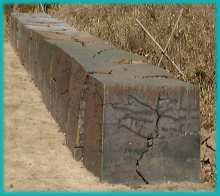 |
 |
| 窖窯(左:屋根の後に2個 の煙突が見える)と 大窯(右奥の建物の中) 春、夏には芝生が緑になる Anagama (left: two chimneies seen behind the roof) and Ohgama (inside the building deep at right hand side) A lawn becomes green in spring and summer. |
窖窯 Anagama |
大窯正面 より詳細はここ をクリック Front of Ohgama Click this for more detail |
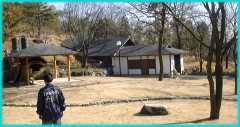 |
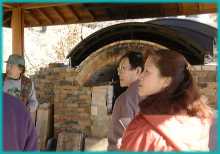 |
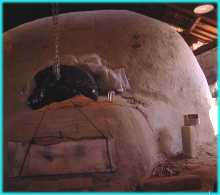 |
| 注 1 萱葺き屋根は岐阜県白川郷の職人によって葺いてもらったもの。 The thatched roof was completed by a craftsman from Shirakawa-go, Gifu pref. 2 まる窯の所定の位置に見本を置いて焼いてから、適当なタイミングで取り出したもの。 寺田氏は窯毎にどの辺りがどのような温度かのノウハウを持っているので、焼成 すべき陶器等は全て、彼が窯内、所定位置に配置する。 These are samples taken out from the Marugama kiln after putting them in place and firing in the kiln. Mr Terada owns know-how on relation between the place and temperature. So, he puts all the ceramics in place in the kiln. 3 ゆらゆらと揺れる炎の左下に見える小さな物体が焼成中のサンプル陶器です。 この窯の内壁は厚み約30CMのクレ(粘土と珪砂の混合物)で出来ており、外壁は厚み 約12CMの耐火レンガで出来ており、合計約42CMの厚みです。 A small object seen at the lower left of wavering flame is sample ceramics under fire. Thickness of the inside wall of the kiln is about 30cm (the wall material is called "Kure" which consists of china clay and silica sand) and the thickness of the outside wall is about 12cm (the material is firebrick). The total thickness, therefore, is about 42cm. 4 1個約1.2トンの直方体10個、合計約12トンの陶製モニュメント。 熱海の山にあるこの作品を愛知県豊田市の現地へ運び込む為に、専用の梱包・搬送用箱 を作り積み降し、配置するのが如何に大変か、想像できるでしょう。 Monument made by pottery consisiting of 10 piecies of rectangular with about 1.2 ton a piece. To transport the monument from the top of mountain at Atami city, Shizuoka prefecture to this place at Toyota city, Aichi prefecture, special boxes for packing and transferring were made. You can easily imagine how it is troublesome. 5 大窯 (大窯の横にあった「蘇った幻の大窯」と題する説明板《寺田康雄氏作成文と 中日新聞記事》から引用): 大窯とは千年の歴史を持つ窖窯(あながま)から、今なお使われ続けている登窯に移行 する約150年間、室町末期から安土、桃山を経て江戸時代初期まで日本の歴史上焼物 が最も表舞台に立った時、瀬戸・美濃にのみ活躍した窯なのです。発掘報告および発掘品 は数多く残されていますが、築窯方法、焼成方法、燃料等々については実証された事がなく 素晴らしい発掘品を見ても、なぜかピンとこないのが本音でした。 着工から2年半、全てに 手探りの復元作業は私たち焼物師にとって最も心おどる時でした。 本年1月初窯を焚くこと により、それらはほぼ解明できました。来春にはいよいよ作品を焚くことが出来るかと・・・。 (寺田氏作成文) 大窯、別名「殿様窯」と呼ばれ、国宝「志野茶碗・卯花檣(うのはながき)」など秀でた作品を 生んだ。 登窯が導入されるまで、桃山時代に隆盛した「わび茶」の茶陶としての黄瀬戸、 瀬戸黒、志野などが大窯で焼かれた。 瀬戸、美濃両地方で約百基の大窯跡が確認され ている。 復元された大窯は高さ2.5米、最大幅4.5米、長さ8米。 岐阜県笠原町で発掘 された大窯の一つ、妙土窯をモデルにしている。 (中日新聞) 5. Ohgam kiln (quoting from an explanation board titled "Revived Dreamlike Ohgama" 《consisting of Mr. Terada's writings and an article of Chunichi Newspaper》 laid at the side of Ohgama kiln) Ohgama kiln played an active part for about 150 years from the middle of 16th century when the existence of earthenware in a history of Japan were most highlighted. This kiln was used for a transition period from Anagama kiln to Climbing kiln only in Seto and Mino area. Although there are many excavation reports and excavated ceramics, how to make Ohgama kiln, how to fire or what the fuel was/were have never been shown by means of evidence. So, I could not have clear impression even if watching splendid excavated ceramics. Now is the time of two and a half year after starting the groping recovery work in all respect, and the most exciting time for potters like me. Trial firing of this Ohgama kiln this year made clear almost all questions. I am looking forward to next spring when we fire ceramics in this kiln at first time. 【Mr. Terada's writings】 Ohgama or "Tonosama-gama" (literally translated to "feudal lord kiln") produced distinguished work such as "Shino-Chawan or teacup of pottery with glaze of Shino called 「Unohanagaki」", national treasure. Until climbing kilns are introduced, pottery with glaze of Kiseto (yellow), Seto-guro (black) or Shino (white or grey) for a style of tasting tea ceremony' called "Wabi-cha" 《the style of tasting is simplified extremely and preferred by some classes, but not by ordinary people - comment by writher of this web page》, which was highlighted in Momoyama era (1572 - 1600), were fired in Ohgama kilns. In both Seto and Mino areas, about 100 kilns have been confirmed. The revived Ohgama kiln is 2.5 m in height, 4.5 m in the maximum width, and 8 m in length. . The model of this kiln is Myudo-gama kiln one of Ohgama kilns which was excavated at Kasahara cho, Gifu prefecture. 【an article of Chunichi Newspaper】 6 清豊寺の由来: 中京大学理事長梅村清弘氏の「清」、豊田市の「豊」、寺田康雄氏の「寺」を合成して、 清豊寺とした。 "Sei-hou-ji" is named by compounding "Sei" representing a part of name of Mr. Kiyohiro Umemura, the chairman of the board of directors of Chukyo University, "hou" a part of city name of Toyota and "ji" a part of name of Mr. Yasuo Terada, ceramic artist. |